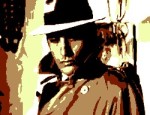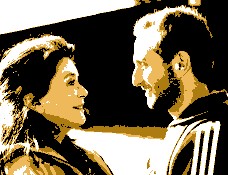Film Review

Scripted by Hitchcock's wife and long-term collaborator Alma Reville, Juno and the Paycock is a blandly slavish adaptation of Seán O'Casey's immensely popular stage play of the same title, which was first performed at the Abbey Theatre, Dublin, on 3rd March 1924 - the first play in his widely acclaimed Dublin Trilogy. It was not the first stage play that Hitchcock had brought to the big screen. He had previously adapted Constance Collier's Downhill (1927), Noel Coward's Easy Virtue (1927) and Eden Phillpott's The Farmer's Wife (1928) as silent films, with his customary flair for inventiveness and visual expression. Restricted both by the primitive recording equipment and a wordy script that was far too close to its source play, Hitchcock had his work cut out for him in his efforts to add Juno and the Paycock to his list of achievements. Whilst the film proved to be popular with critics and audiences on its first release in 1930, the director disliked it hugely and considered it an immense personal failure - and not without reason.
As the film's leading character, Sara Allgood does a good job reprising the title role Juno that brought her most acclaim, with a powerful mater dolorosa performance well-suited to screen melodramas of this era. A fine actress of stage and screen, she also appeared in Hitchcock's Blackmail and later went on to receive an Oscar nomination for her performance in John Ford's How Green Was My Valley (1941). Allgood's stage co-star Barry Fitzgerald makes his screen debut in the film, not in the part he created on stage but in a much smaller role, as the street orator in the film's dramatic opening scene. Fitzgerald's part in the original play went to the established character actor Edward Chapman, an admirable choice as his likable roguish persona and penchant for deadpan comedy helps to humanise a pretty unsympathetic character. Today, Chapman is best known for playing Norman Wisdom's sidekick in a series of popular British film comedies of the 1950s and '60s - including The Square Peg (1958) and A Stitch in Time (1963). Hitchcock was sufficiently taken with the actor to work with him on two subsequent films - Murder! (1930) and The Skin Game (1931). Another instantly recognisable face is John Laurie, who can hardly help stealing the focus whenever he enters the frame with his arresting and poignant portrayal of a former Republican combatant deeply traumatised by his military activities.
Juno and the Paycock is the least inspired and most badly dated of all of Alfred Hitchcock's films but it could have been a lot worse. Perhaps mindful of how horrendously static and lifeless this direct stage-to-screen offering risked being, Hitchcock employs longer shots than would normally have been expected, with the camera moving from character to character within a scene to avoid cuts that would have reduced the sequence to an unbearable series of static portrait shots (something the director hated). By opening the film with a street scene and then a scene in a pub, with a few subsequent cutaway shots to the street, Hitchcock avoids the necessity to locate the entire film in one set (the Boyles' cramped Dublin apartment), but the exigencies of the script limit the director's freedom of movement considerably and he fails to overcome the one fundamental flaw with the production - its highly static and localised nature. (It is interesting to compare this film with Hitchcock's later equally confined Lifeboat (1944) - this imposed even greater restrictions which the director managed to overcome by straining his ingenuity to the limit, although by this time cameras were far more mobile and studios better equipped.)
The camera techniques which the director had developed and mastered on his earlier silent films would have been inappropriate on the dialogue-heavy Juno and the Paycock, and so the only area where he could exercise his inventiveness was in the use of background sound. Intermittent blasts of gunfire from the street outside the apartment are a constant reminder that the story takes place at a violent time in Ireland's history, adding an underlying sustained tension to the drama that would not have been apparent in the original stage production. This is the film's one touch of genius.
Hitchcock learned a valuable but painful lesson from Juno and the Paycock, which was that he should never have stuck so rigorously to the original text. In most of his subsequent adaptations of existing works - notably Rebecca (1940), Strangers on a Train (1951), Psycho (1960) and The Birds (1963) - he would take the central idea and use this as the starting point for what he thought would make an interesting film, effectively changing the subject to fit his style. The fundamental problem with Juno and the Paycock is that its author allowed himself to be forced to surrender his idiosyncratic concept of pure cinema in the service of the original play, the result being a stillborn theatre-cinema hybrid that is almost unremittingly dull and characterless.
© James Travers 2023
The above content is owned by frenchfilms.org and must not be copied.
Film Synopsis
Ireland, 1922. During the Irish Civil War, Captain Jack Boyle rents a small two-room flat in the crowded slums of Dublin, sharing his cramped quarters with his bossy wife Juno and their two grown-up children, Mary and Johnny. With Boyle unable to find paid work and Johnny now a moody invalid after losing both an arm and his mind in the struggle for Irish independence, it is Juno and Mary who are the family breadwinners. Things look up when Mary's new boyfriend, Charlie Bentham, visits the family with the news that the Captain has inherited two thousand pounds from a recently deceased cousin. The Boyles waste no time making the most of their good fortune. Soon their tiny apartment is filled with brand new furniture, acquired on hire purchase, and the Boyles are hosting a party to celebrate their unexpected windfall. All too soon comes the discovery that the expected inheritance is not going to come the Boyles' way after all, owing to Bentham's careless mis-drafting of the will. Exposed as an informant and traitor to his own side, Johnny is abducted by his former IRA associates and executed, whilst Bentham abandons Mary after learning she is pregnant with his child. Even though her world has fallen apart, Juno takes comfort in her Christian faith as she mourns the violent death of her son in her now totally empty flat.© James Travers
The above content is owned by frenchfilms.org and must not be copied.
Similar Films
Here are some other films you may enjoy watching:Film Credits
- Director: Alfred Hitchcock
- Script: Sean O'Casey (play), Alfred Hitchcock, Alma Reville
- Cinematographer: Jack E. Cox
- Cast: Sara Allgood (Mrs Boyle), Edward Chapman (Captain Jack Boyle), Barry Fitzgerald (The Orator), Maire O'Neill (Mrs Maisie Madigan), Sidney Morgan (Joxer Daly), John Laurie (Johnny Boyle), Dave Morris (Jerry Devine), Kathleen O'Regan (Mary Boyle), John Longden (Charles Bentham), Dennis Wyndham (Mobiliser), Fred Schwartz (Mr. Kelly), Donald Calthrop (Needle Nugent)
- Country: UK
- Language: English
- Support: Black and White
- Runtime: 95 min
- Aka: The Shame of Mary Boyle
The very best French thrillers

The Carry On films, from the heyday of British film comedy

